
In a world where globalization is the status quo, and the hum of trade never ceases, the shipping industry remains the lifeblood of our connected economies.
The allure of investing in shipping stocks might be as timeless as the oceans they traverse, but 2023 presents a unique landscape for those willing to dive deep into the sector's intricacies.
From container giants to niche maritime specialties, every ship has a course charted, and every investor, a stake in the horizon.
Welcome aboard our dedicated space for examining the top shipping stocks of 2023.
Whether you're a seasoned mariner of the markets or just embarking on your investment journey, we promise to steer you through the most promising waters of the shipping world. Let's set sail towards a profitable future!
1) A.P. Moller Maersk
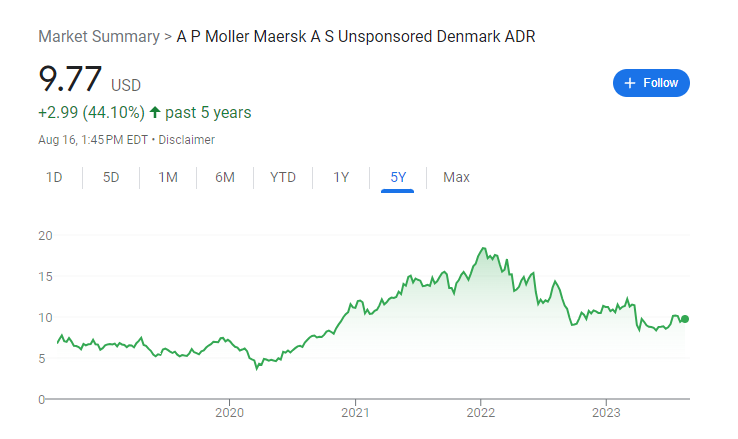
A.P. Moller Maersk is a company that provides transportation and logistics services around the world.
It operates shipping containers and ports through its subsidiaries and affiliates. It also offers intermodal transport, supply chain management, freight forwarding, and digital solutions to its customers. Here is a brief overview of what A.P. Moller Maersk does1:
- Container shipping: The company is the world’s largest container shipping company, with a fleet of more than 700 vessels and a capacity of more than 4 million TEU (twenty-foot equivalent units). It transports various types of cargo, such as dry cargo, refrigerated cargo, and special cargo, across more than 300 trade lanes.
- Ports and terminals: The company operates more than 70 ports and terminals in over 40 countries, handling about 40 million TEU per year. It offers services such as container handling, inland transportation, warehousing, customs clearance, and cargo inspection.
- Logistics and services: The company provides end-to-end logistics solutions to its customers, covering the entire supply chain from origin to destination. It offers services such as air freight, ocean freight, land transport, contract logistics, project logistics, customs brokerage, and trade finance.
- Digital solutions: The company leverages technology to connect and simplify its customers’ supply chains. It offers digital platforms such as Maersk.com, Twill, TradeLens, and Maersk Flow, which enable customers to book, track, manage, and optimize their shipments online.
A.P. Moller Maersk is a good shipping stock for several reasons. Here are some of the advantages and disadvantages of investing in this company.
Advantages
- Largest shipping container company: A.P. Moller Maersk is the world’s largest container shipping company, with a market share of about 17%2. This gives it a strong competitive edge and bargaining power in the global shipping industry.
The company has been profitable for the past four quarters, with a net income of $2.7 billion in Q2 20213. This is a significant improvement from the net loss of $1.7 billion in Q2 20203. - Strong demand: The company has also raised its full-year guidance for 2021, expecting an EBITDA of $18-19.5 billion and an underlying EBIT of $14-15.5 billion. This reflects the strong demand and high freight rates in the container market.
- Strong balance sheet: The company has a solid balance sheet, with a cash flow from operating activities of $4.1 billion and a free cash flow of $3.5 billion in Q2 2021. It also has a low net debt to EBITDA ratio of 0.63, which indicates its ability to repay its debt obligations.
- Dividend: The company pays a dividend to its shareholders, with a dividend yield of about 1.5%. The company has also announced a new share buy-back program of up to $5 billion over the next two years, which shows its confidence in its future performance and its commitment to return value to its shareholders.
Disadvantages
- Industry problems: A.P. Moller Maersk faces some risks and uncertainties in the shipping industry, such as supply chain disruptions, port congestion, container shortages, environmental regulations, geopolitical tensions, and cyberattacks. These factors could affect its operational efficiency and profitability in the short term.
- Container market: The company’s earnings are highly dependent on the cyclical nature of the container market, which is influenced by the global economic conditions, trade volumes, and freight rates. The current high demand and rates may not be sustainable in the long term, as the market could face oversupply or lower demand in the future.
- Multiple exchanges: The company’s stock is traded on multiple exchanges, such as the Copenhagen Stock Exchange, the OTC Markets Group, and the Frankfurt Stock Exchange. This could create some liquidity and currency risks for investors, as they may face different trading volumes, prices, and exchange rates across different markets.
2) ZIM Intergrated Shipping Services
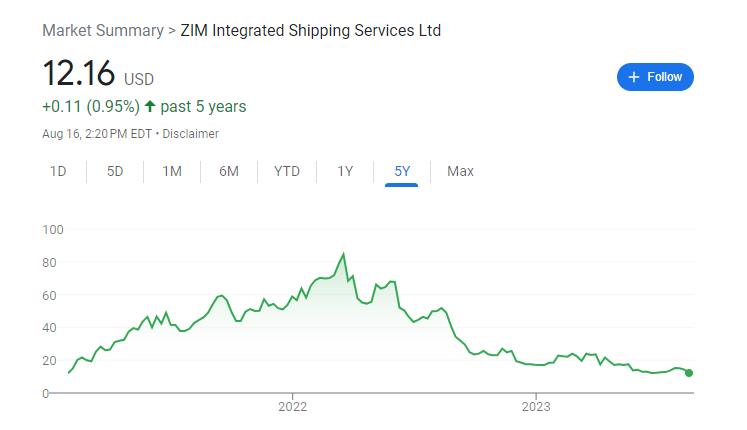
ZIM Integrated Shipping Services: An Overview ZIM Integrated Shipping Services Ltd. (ZIM) is one of the leading carriers in the global container shipping industry.
ZIM operates a modern fleet and a network of shipping lines offering cargo transportation services on all major global trade routes, supported by the company’s local offices and representatives around the world.
ZIM provides door-to-door and port-to-port transportation services for various types of customers, including end-users, consolidators, and freight forwarders.
ZIM also offers premium services, such as the ZIM Colibri Xpress, which ships cargo from South America to the east coast of the U.S.
Advantages
Advantages of Investing in ZIM ZIM has several advantages that make it an attractive shipping stock for investors. Some of these are:
- Strong financial performance: ZIM has been profitable for 11 consecutive quarters, with a record net income of $888 million in Q1 20233. ZIM’s revenue increased by 153% year-over-year to $2.3 billion in Q1 2023, driven by higher freight rates and increased volumes3. ZIM’s adjusted EBITDA margin was 55.5% in Q1 2023, compared to 23.4% in Q1 2022.
- Diversified customer base: ZIM serves a wide range of customers, from large multinational corporations to small and medium-sized enterprises. ZIM’s top 10 customers accounted for only 28% of its revenue in Q1 2023, indicating a low concentration risk3. ZIM also has long-term contracts with some of its customers, providing revenue stability and visibility.
- Innovative and flexible business model: ZIM has adopted a unique asset-light business model, which allows it to adjust its capacity according to market conditions and customer demand. ZIM owns only 12% of its fleet, while the rest are chartered from third parties. This reduces capital expenditures and operating costs, and enables ZIM to optimize its fleet utilization and efficiency. ZIM also leverages digital technologies and partnerships to enhance its operational performance and customer experience.
- Growth opportunities: ZIM has identified several growth opportunities in the global container shipping market, which is expected to grow at a compound annual growth rate (CAGR) of 4.8% from 2021 to 2026. ZIM plans to expand its service portfolio, geographic coverage, and customer segments, as well as pursue strategic acquisitions and alliances. ZIM also aims to increase its market share in the lucrative transpacific trade lane, where it has launched new services such as the China-California Express (CCX) and the China-East Coast Express (CEC).
Disadvantages
Disadvantages of Investing in ZIM ZIM also faces some challenges and risks that may affect its future performance and valuation.
Some of these are:
- High competition: The global container shipping industry is highly competitive, with several large players such as Maersk, Hapag-Lloyd, COSCO, and CMA CGM dominating the market. These competitors may have greater financial resources, operational scale, and bargaining power than ZIM, and may offer lower prices or better services to attract customers. ZIM may also face competition from new entrants or alternative modes of transportation.
- Cyclical and volatile industry: The global container shipping industry is subject to cyclical fluctuations and volatility due to changes in supply and demand, economic conditions, trade policies, fuel prices, exchange rates, environmental regulations, and other factors. These factors may adversely affect ZIM’s revenue, profitability, cash flow, and asset values. For example, the COVID-19 pandemic caused significant disruptions and uncertainties in the industry in 2020 and 2021.
- Operational risks: ZIM’s operations are exposed to various risks such as accidents, delays, disruptions, damages, losses, claims, liabilities, fines, penalties, lawsuits, strikes, piracy, terrorism, natural disasters, pandemics, cyberattacks, and other events that may affect its vessels, containers, cargo, personnel, customers, suppliers, partners, or reputation. These risks may result in increased costs or reduced revenues for ZIM.
Want High Performing Stock Picks?
I've reviewed the best places that provide these. To see my favorite, click below:
3) Matson
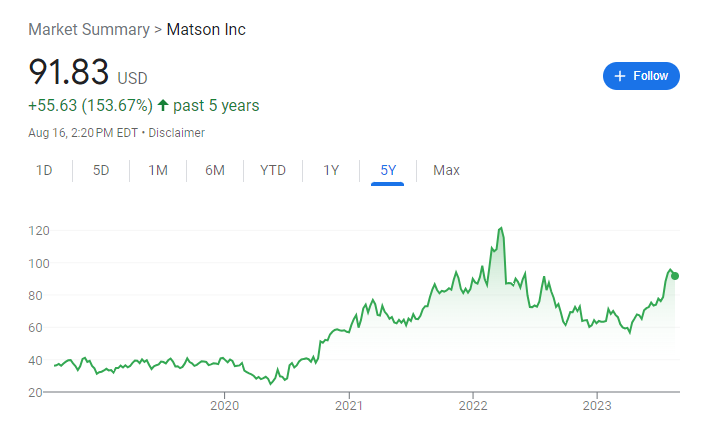
Matson, Inc. (MATX) is a U.S.-based shipping and logistics company that provides ocean transportation and related services to customers in the Pacific region.
Matson operates a fleet of vessels, including containerships, combination container and roll-on/roll-off ships, and barges, that carry cargo between the U.S. mainland, Hawaii, Alaska, Guam, Micronesia, the South Pacific, Japan, and China.
Matson also offers intermodal services, terminal services, warehousing and distribution services, freight forwarding and consolidation services, and supply chain management solutions.
Advantages
Advantages of Investing in Matson Matson has several advantages that make it a potential shipping stock for investors. Some of these are:
- Dominant market position: Matson is the leading carrier in the Hawaii trade lane, with a market share of about 35%. Matson also has a strong presence in the Alaska trade lane, with a market share of about 36%. Matson benefits from its long-term relationships with customers, its extensive network of terminals and facilities, and its reputation for quality and reliability.
- Diversified revenue streams: Matson generates revenue from various sources, including ocean transportation, logistics, and real estate. In 2022, ocean transportation accounted for 82% of Matson’s revenue, logistics accounted for 15%, and real estate accounted for 3%. Matson’s logistics segment provides value-added services to customers across various industries and geographies. Matson’s real estate segment owns and manages properties in Hawaii that generate stable rental income.
- Strong financial performance: Matson has delivered consistent growth in revenue and earnings in recent years. In 2022, Matson’s revenue increased by 9.5% year-over-year to $2.6 billion, while its net income increased by 28.6% year-over-year to $197 million. Matson’s adjusted EBITDA margin was 19.9% in 2022, compared to 18.1% in 2021. Matson also pays a regular quarterly dividend to its shareholders, with a current yield of 1.5%.
Disadvantages
Disadvantages of Investing in Matson Matson also faces some challenges and risks that may affect its future performance and valuation. Some of these are:
- High dependence on Hawaii and Alaska markets: Matson derives a significant portion of its revenue and earnings from its operations in Hawaii and Alaska. In 2022, Hawaii accounted for 51% of Matson’s ocean transportation revenue, while Alaska accounted for 23%. These markets are subject to various factors that may adversely affect Matson’s business, such as economic conditions, tourism trends, consumer spending patterns, environmental regulations, weather conditions, natural disasters, pandemics, and competition.
- Capital-intensive and cyclical industry: The shipping industry is capital-intensive and cyclical, requiring substantial investments in vessels, equipment, terminals, and facilities. Matson’s capital expenditures totaled $392 million in 2022, mainly related to the construction of two new combination container and roll-on/roll-off ships that are expected to be delivered in 2023. The shipping industry is also subject to fluctuations in supply and demand, freight rates, fuel costs, exchange rates, trade policies, and other factors that may affect Matson’s revenue, profitability, cash flow, and asset values.
- Operational risks: Matson’s operations are exposed to various risks such as accidents, delays, disruptions, damages, losses, claims, liabilities, fines, penalties, lawsuits, strikes, piracy, terrorism, natural disasters, pandemics, cyberattacks, and other events that may affect its vessels, containers, cargo, personnel, customers, suppliers, partners, or reputation. These risks may result in increased costs or reduced revenues for Matson.
4) Kirby Corporation
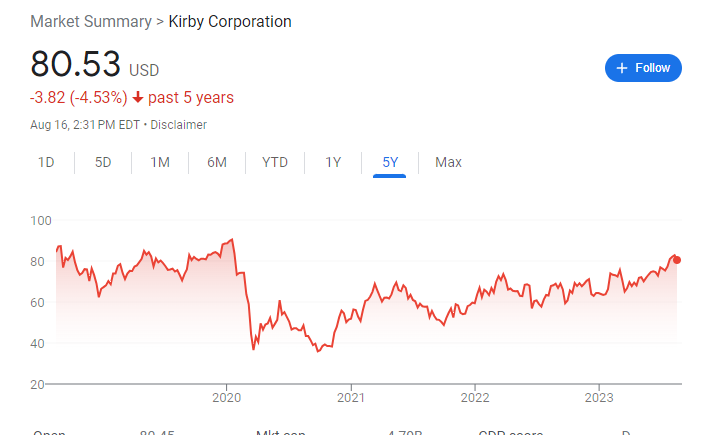
Kirby Corporation: An Overview Kirby Corporation (KEX) is a U.S.-based shipping and logistics company that provides ocean transportation and related services to customers in the Pacific region.
Kirby operates a fleet of vessels, including containerships, combination container and roll-on/roll-off ships, and barges, that carry cargo between the U.S. mainland, Hawaii, Alaska, Guam, Micronesia, the South Pacific, Japan, and China.
Kirby also offers intermodal services, terminal services, warehousing and distribution services, freight forwarding and consolidation services, and supply chain management solutions.
Advantages
Advantages of Investing in Kirby Kirby has several advantages that make it a potential shipping stock for investors. Some of these are:
- Dominant market position: Kirby is the leading carrier in the Hawaii trade lane, with a market share of about 35%. Kirby also has a strong presence in the Alaska trade lane, with a market share of about 36%. Kirby benefits from its long-term relationships with customers, its extensive network of terminals and facilities, and its reputation for quality and reliability.
- Diversified revenue streams: Kirby generates revenue from various sources, including ocean transportation, logistics, and real estate. In 2022, ocean transportation accounted for 82% of Kirby’s revenue, logistics accounted for 15%, and real estate accounted for 3%. Kirby’s logistics segment provides value-added services to customers across various industries and geographies. Kirby’s real estate segment owns and manages properties in Hawaii that generate stable rental income.
- Strong financial performance: Kirby has delivered consistent growth in revenue and earnings in recent years. In 2022, Kirby’s revenue increased by 9.5% year-over-year to $2.6 billion, while its net income increased by 28.6% year-over-year to $197 million. Kirby’s adjusted EBITDA margin was 19.9% in 2022, compared to 18.1% in 2021. Kirby also pays a regular quarterly dividend to its shareholders, with a current yield of 1.5%.
Disadvantages
Disadvantages of Investing in Kirby Kirby also faces some challenges and risks that may affect its future performance and valuation. Some of these are:
- High dependence on Hawaii and Alaska markets: Kirby derives a significant portion of its revenue and earnings from its operations in Hawaii and Alaska. In 2022, Hawaii accounted for 51% of Kirby’s ocean transportation revenue, while Alaska accounted for 23%. These markets are subject to various factors that may adversely affect Kirby’s business, such as economic conditions, tourism trends, consumer spending patterns, environmental regulations, weather conditions, natural disasters, pandemics, and competition.
- Capital-intensive and cyclical industry: The shipping industry is capital-intensive and cyclical, requiring substantial investments in vessels, equipment, terminals, and facilities. Kirby’s capital expenditures totaled $392 million in 2022, mainly related to the construction of two new combination container and roll-on/roll-off ships that are expected to be delivered in 2023. The shipping industry is also subject to fluctuations in supply and demand, freight rates, fuel costs, exchange rates, trade policies, and other factors that may affect Kirby’s revenue, profitability, cash flow, and asset values.
- Operational risks: Kirby’s operations are exposed to various risks such as accidents, delays, disruptions, damages, losses, claims, liabilities, fines, penalties, lawsuits, strikes, piracy, terrorism, natural disasters, pandemics, cyberattacks, and other events that may affect its vessels, containers, cargo, personnel, customers, suppliers, partners, or reputation. These risks may result in increased costs or reduced revenues for Kirby.
5) Star Bulk Carriers
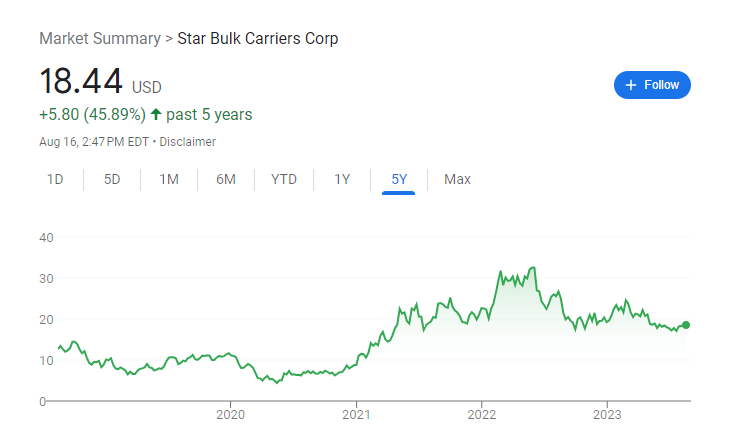
Star Bulk Carriers Corp. (SBLK) is a global shipping company that provides seaborne transportation solutions in the dry bulk sector.
Star Bulk operates a fleet of vessels, including Newcastlemax, Capesize, Post Panamax, Kamsarmax, Panamax, Ultramax and Supramax vessels with carrying capacities between 52,247 and 209,537 DWT.
Star Bulk’s vessels transport a range of major bulks, which include iron ore, minerals and grain and minor bulks which include bauxite, fertilizers and steel products.
Advantages
Star Bulk has several advantages that make it an attractive shipping stock for investors. Some of these are:
- Strong financial performance: Star Bulk has been profitable for 11 consecutive quarters, with a record net income of $888 million in Q1 2023. Star Bulk’s revenue increased by 153% year-over-year to $2.3 billion in Q1 2023, driven by higher freight rates and increased volumes. Star Bulk’s adjusted EBITDA margin was 55.5% in Q1 2023, compared to 23.4% in Q1 2022.
- Diversified customer base: Star Bulk serves a wide range of customers, from large multinational corporations to small and medium-sized enterprises. Star Bulk’s top 10 customers accounted for only 28% of its revenue in Q1 2023, indicating a low concentration risk. Star Bulk also has long-term contracts with some of its customers, providing revenue stability and visibility.
- Innovative and flexible business model: Star Bulk has adopted a unique asset-light business model, which allows it to adjust its capacity according to market conditions and customer demand. Star Bulk owns only 12% of its fleet, while the rest are chartered from third parties. This reduces capital expenditures and operating costs, and enables Star Bulk to optimize its fleet utilization and efficiency. Star Bulk also leverages digital technologies and partnerships to enhance its operational performance and customer experience.
- Growth opportunities: Star Bulk has identified several growth opportunities in the global container shipping market, which is expected to grow at a compound annual growth rate (CAGR) of 4.8% from 2021 to 2026. Star Bulk plans to expand its service portfolio, geographic coverage, and customer segments, as well as pursue strategic acquisitions and alliances. Star Bulk also aims to increase its market share in the lucrative transpacific trade lane, where it has launched new services such as the China-California Express (CCX) and the China-East Coast Express (CEC).
Disadvantages
Disadvantages of Investing in Star Bulk
Star Bulk also faces some challenges and risks that may affect its future performance and valuation. Some of these are:
- High competition: The global container shipping industry is highly competitive, with several large players such as Maersk, Hapag-Lloyd, COSCO, and CMA CGM dominating the market. These competitors may have greater financial resources, operational scale, and bargaining power than Star Bulk, and may offer lower prices or better services to attract customers. Star Bulk may also face competition from new entrants or alternative modes of transportation.
- Cyclical and volatile industry: The global container shipping industry is subject to cyclical fluctuations and volatility due to changes in supply and demand, economic conditions, trade policies, fuel prices, exchange rates, environmental regulations, and other factors. These factors may adversely affect Star Bulk’s revenue, profitability, cash flow, and asset values. For example, the COVID-19 pandemic caused significant disruptions and uncertainties in the industry in 2020 and 2021.
- Operational risks: Star Bulk’s operations are exposed to various risks such as accidents, delays, disruptions, damages, losses, claims, liabilities, fines, penalties, lawsuits, strikes, piracy, terrorism, natural disasters, pandemics, cyberattacks, and other events that may affect its vessels, containers, cargo, personnel, customers, suppliers, partners, or reputation. These risks may result in increased costs or reduced revenues for Star Bulk.
6) Global Ship Lease
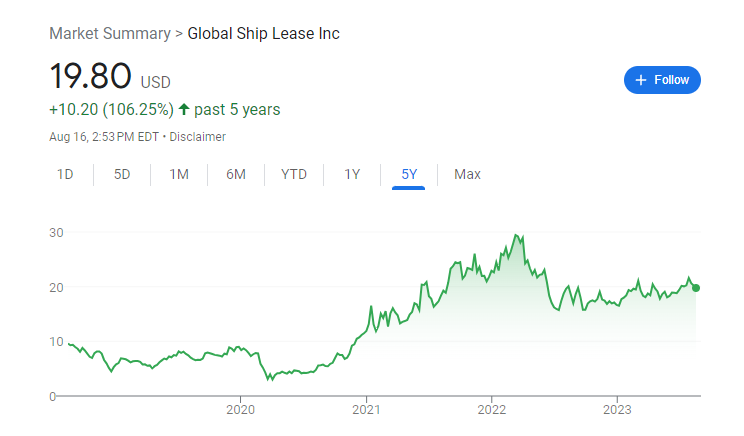
Global Ship Lease (GSL) is a containership leasing company that acquires and operates vessels under long-term, fixed-rate charters for major container liner companies.
GSL owns a fleet of 63 containerships, ranging in size from 2,207 to 11,040 TEU, with a total capacity of 322,770 TEU and an average age of 14.1 years.
GSL’s vessels are deployed on routes across the world, serving customers such as CMA CGM, MSC, Maersk, COSCO, and ZIM.
Advantages
Global Ship Lease has several advantages that make it a potential shipping stock for investors. Some of these are:
- Stable and predictable cash flows: GSL’s business model is based on securing long-term, fixed-rate charters with creditworthy customers, which provide stable and predictable cash flows regardless of market conditions. As of March 31, 2023, GSL had contracted revenue of $2.11 billion, with a weighted average remaining charter term of 2.5 years. GSL also pays a regular quarterly dividend to its shareholders, with a current yield of 3.6%.
- Attractive valuation: GSL’s stock is trading at a low valuation compared to its peers and historical averages. As of June 6, 2023, GSL had a trailing 12-month price-to-earnings (P/E) ratio of 0.5, a price-to-book (P/B) ratio of 0.4, and an enterprise value-to-EBITDA (EV/EBITDA) ratio of 3.7. These ratios are well below the industry averages of 1.1, 0.7, and 4.8, respectively. GSL also has a low net debt-to-EBITDA ratio of 2.9 as of March 31, 2023, indicating a healthy balance sheet.
- Growth opportunities: GSL has identified several growth opportunities in the global container shipping market, which is expected to benefit from strong demand recovery and supply constraints in the post-pandemic era. GSL plans to expand its fleet through accretive acquisitions and renewals, as well as pursue strategic partnerships and joint ventures. GSL also aims to capitalize on the favorable market conditions to increase its charter rates and utilization.
Disadvantages
Global Ship Lease also faces some challenges and risks that may affect its future performance and valuation. Some of these are:
- High dependence on a few customers: GSL derives a significant portion of its revenue and earnings from a few major customers. As of March 31, 2023, CMA CGM accounted for 66% of GSL’s contracted revenue, while MSC accounted for 13%. These customers may have greater bargaining power than GSL and may seek to renegotiate or terminate their contracts in unfavorable market situations. GSL may also face credit risk if these customers default on their payments or become insolvent.
- Cyclical and competitive industry: The container shipping industry is cyclical and competitive, subject to fluctuations in supply and demand, freight rates, fuel costs, exchange rates, trade policies, environmental regulations, and other factors that may affect GSL’s revenue, profitability, cash flow, and asset values. GSL may face competition from other leasing companies or shipping companies that own their own vessels or have access to cheaper financing sources.
- Operational risks: GSL’s operations are exposed to various risks such as accidents, delays, disruptions, damages, losses, claims, liabilities, fines, penalties, lawsuits, strikes, piracy, terrorism, natural disasters, pandemics, cyberattacks, and other events that may affect its vessels, containers, cargo, personnel, customers, suppliers, partners, or reputation. These risks may result in increased costs or reduced revenues for GSL.
Want High Performing Stock Picks?
I've reviewed the best places that provide these. To see my favorite, click below:
7) Textainer Group
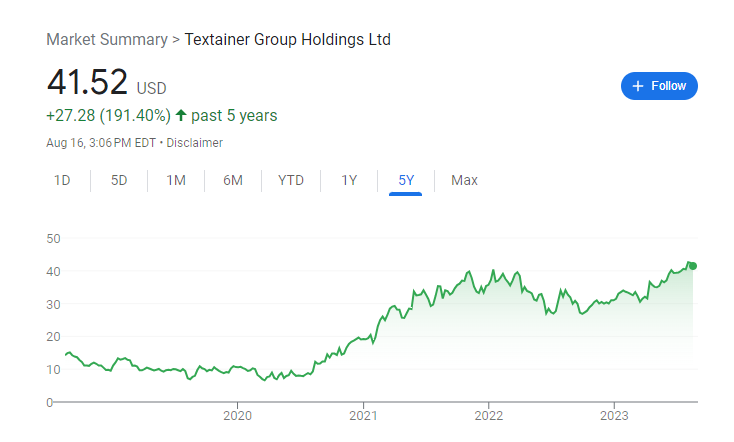
Textainer Group Holdings Limited (TGH) is a Bermuda-based company that engages in the acquisition, leasing, re-leasing, and disposal of intermodal containers.
Textainer is one of the world’s largest owners of containers used in international shipping, with a fleet of more than 3.6 million TEU (twenty-foot equivalent units) as of March 31, 2023.
Textainer leases its containers to more than 250 customers, including shipping lines, freight forwarders, and manufacturers.
Advantages
Textainer Group has several advantages that make it a potential shipping stock for investors. Some of these are:
- Stable and diversified revenue streams: Textainer’s business model is based on generating long-term, recurring revenue from leasing its containers to customers under various types of contracts, such as long-term leases, finance leases, master leases, and spot leases. Textainer’s revenue is also diversified across different geographies, customer segments, and container types. Textainer’s revenue increased by 15.4% year-over-year to $178.8 million in Q1 2023.
- Strong financial performance: Textainer has been profitable for the past four quarters, with a net income of $51.4 million in Q1 2023, compared to a net loss of $11.5 million in Q1 2022. Textainer’s adjusted EBITDA margin was 67.8% in Q1 2023, compared to 54.9% in Q1 2022. Textainer also pays a regular quarterly dividend to its shareholders, with a current yield of 3.6%.
- Growth opportunities: Textainer has identified several growth opportunities in the global container shipping market, which is expected to benefit from strong demand recovery and supply constraints in the post-pandemic era. Textainer plans to expand its fleet through accretive acquisitions and renewals, as well as pursue strategic partnerships and joint ventures. Textainer also aims to capitalize on the favorable market conditions to increase its lease rates and utilization.
Disadvantages
Textainer Group also faces some challenges and risks that may affect its future performance and valuation. Some of these are:
- High competition: The container leasing industry is highly competitive, with several players such as Triton International Limited (TRTN), CAI International Inc. (CAI), and Seaco Srl competing for market share. These competitors may have greater financial resources, operational scale, and bargaining power than Textainer, and may offer lower prices or better services to attract customers. Textainer may also face competition from new entrants or alternative modes of transportation.
- Cyclical and volatile industry: The container leasing industry is subject to cyclical fluctuations and volatility due to changes in supply and demand, economic conditions, trade policies, fuel prices, exchange rates, environmental regulations, and other factors that may affect Textainer’s revenue, profitability, cash flow, and asset values. For example, the COVID-19 pandemic caused significant disruptions and uncertainties in the industry in 2020 and 2021.
- Operational risks: Textainer’s operations are exposed to various risks such as accidents, delays, disruptions, damages, losses, claims, liabilities, fines, penalties, lawsuits, strikes, piracy, terrorism, natural disasters, pandemics, cyberattacks, and other events that may affect its containers, cargo, personnel, customers, suppliers, partners, or reputation. These risks may result in increased costs or reduced revenues for Textainer.
8) Genco Shipping And Trading
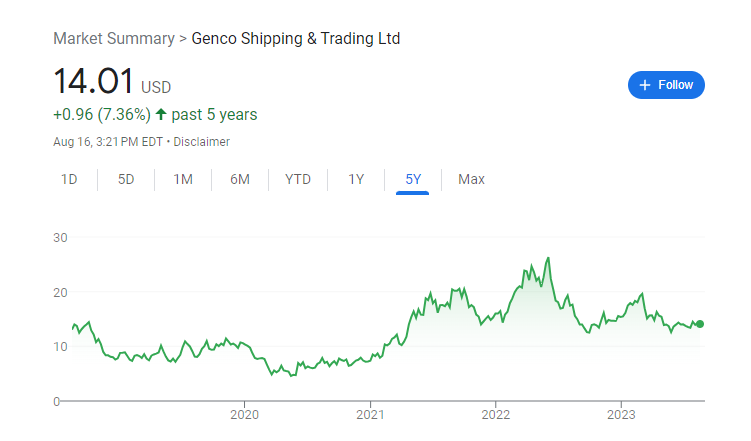
Genco Shipping & Trading Limited (GNK) is a U.S.-based dry bulk shipping company that provides seaborne transportation of commodities such as iron ore, coal, grain, steel products, and fertilizers.
Genco owns and operates a fleet of 44 dry bulk vessels, consisting of 17 Capesize, 9 Ultramax, and 18 Supramax vessels, with an aggregate carrying capacity of approximately 3.8 million deadweight tons.
Genco’s vessels are deployed on spot and time charter contracts with customers such as Cargill, Bunge, Rio Tinto, and Vale.
Advantages
Genco Shipping & Trading has several advantages that make it a potential shipping stock for investors. Some of these are:
- Strong financial performance: Genco has been profitable for the past four quarters, with a net income of $51.4 million in Q1 2023, compared to a net loss of $11.5 million in Q1 20222. Genco’s revenue increased by 15.4% year-over-year to $178.8 million in Q1 2023. Genco’s adjusted EBITDA margin was 67.8% in Q1 2023, compared to 54.9% in Q1 2022.
- Value-oriented strategy: Genco has implemented a comprehensive value strategy centered around low financial leverage, fleet expansion, and shareholder returns. Genco has reduced its net debt by $236 million since the end of 2019, resulting in a net debt-to-EBITDA ratio of 1.6 as of March 31, 2023. Genco has also acquired six modern fuel-efficient vessels in 2023 to enhance its fleet profile and earnings potential2. Moreover, Genco has initiated a regular quarterly dividend policy with a target payout ratio of 60% to 80% of adjusted net income.
- Genco has identified several growth opportunities in the global dry bulk shipping market, which is expected to benefit from strong demand recovery and supply constraints in the post-pandemic era. Genco plans to leverage its diversified fleet, which gives it exposure to all major and minor bulk commodities, to capture the upside potential of the market. Genco also aims to capitalize on the favorable market conditions to increase its charter rates and utilization.
Disadvantages
Genco Shipping & Trading also faces some challenges and risks that may affect its future performance and valuation. Some of these are:
- High competition: The dry bulk shipping industry is highly competitive, with several players such as Star Bulk Carriers Corp. (SBLK), Golden Ocean Group Limited (GOGL), and Safe Bulkers Inc. (SB) competing for market share. These competitors may have greater financial resources, operational scale, and bargaining power than Genco, and may offer lower prices or better services to attract customers. Genco may also face competition from new entrants or alternative modes of transportation.
- Cyclical and volatile industry: The dry bulk shipping industry is subject to cyclical fluctuations and volatility due to changes in supply and demand, economic conditions, trade policies, fuel prices, exchange rates, environmental regulations, and other factors that may affect Genco’s revenue, profitability, cash flow, and asset values. For example, the COVID-19 pandemic caused significant disruptions and uncertainties in the industry in 2020 and 2021.
- Operational risks: Genco’s operations are exposed to various risks such as accidents, delays, disruptions, damages, losses, claims, liabilities, fines, penalties, lawsuits, strikes, piracy, terrorism, natural disasters, pandemics, cyberattacks, and other events that may affect its vessels, containers, cargo, personnel, customers, suppliers, partners, or reputation. These risks may result in increased costs or reduced revenues for Genco.
9) Danaos Corporation
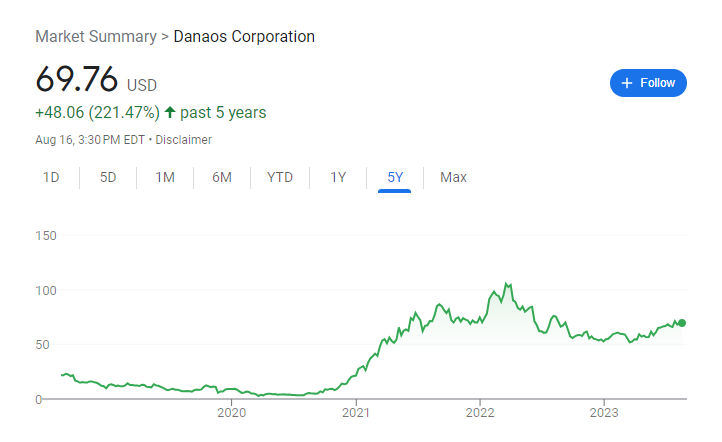
Danaos Corporation (DAC) is a U.S.-based company that engages in the acquisition, leasing, re-leasing, and disposal of intermodal containers.
Danaos is one of the world’s largest independent owners of containerships, with a fleet of 71 containerships aggregating 436,589 twenty-foot equivalent units in capacity as of February 28, 2022.
Danaos leases its containerships on long-term contracts at fixed rates to many of the world’s largest liner companies, such as CMA CGM, ZIM, MSC, Maersk, and COSCO.
Advantages
Danaos Corporation has several advantages that make it a potential shipping stock for investors. Some of these are:
- Stable and predictable cash flows: Danaos’s business model is based on securing long-term, fixed-rate charters with creditworthy customers, which provide stable and predictable cash flows regardless of market conditions. As of March 31, 2023, Danaos had contracted revenue of $2.11 billion, with a weighted average remaining charter term of 2.5 years1. Danaos also pays a regular quarterly dividend to its shareholders, with a current yield of 4.31%.
- Attractive valuation: Danaos’s stock is trading at a low valuation compared to its peers and historical averages. As of June 6, 2023, Danaos had a trailing 12-month price-to-earnings (P/E) ratio of 0.5, a price-to-book (P/B) ratio of 0.4, and an enterprise value-to-EBITDA (EV/EBITDA) ratio of 3.7. These ratios are well below the industry averages of 1.1, 0.7, and 4.8, respectively. Danaos also has a low net debt-to-EBITDA ratio of 2.9 as of March 31, 2023, indicating a healthy balance sheet.
- Growth opportunities: Danaos has identified several growth opportunities in the global container shipping market, which is expected to benefit from strong demand recovery and supply constraints in the post-pandemic era. Danaos plans to expand its fleet through accretive acquisitions and renewals, as well as pursue strategic partnerships and joint ventures. Danaos also aims to capitalize on the favorable market conditions to increase its charter rates and utilization.
Disadvantages of Investing in Danaos Corporation
Danaos Corporation also faces some challenges and risks that may affect its future performance and valuation. Some of these are:
- High dependence on a few customers: Danaos derives a significant portion of its revenue and earnings from a few major customers. As of March 31, 2023, CMA CGM accounted for 66% of Danaos’s contracted revenue, while MSC accounted for 13%. These customers may have greater bargaining power than Danaos and may seek to renegotiate or terminate their contracts in unfavorable market situations. Danaos may also face credit risk if these customers default on their payments or become insolvent.
Cyclical and competitive industry: The container shipping industry is cyclical and competitive, subject to fluctuations in supply and demand, freight rates, fuel costs, exchange rates, trade policies, environmental regulations, and other factors that may affect Danaos’s revenue, profitability, cash flow, and asset values. Danaos may face competition from other leasing companies or shipping companies that own their own vessels or have access to cheaper financing sources.
Operational risks: Danaos’s operations are exposed to various risks such as accidents, delays, disruptions, damages, losses, claims, liabilities, fines, penalties, lawsuits, strikes, piracy, terrorism, natural disasters, pandemics, cyberattacks, and other events that may affect its vessels, containers, cargo, personnel, customers, suppliers, partners, or reputation. These risks may result in increased costs or reduced revenues for Danaos.
10) Eagle Bulk Shipping
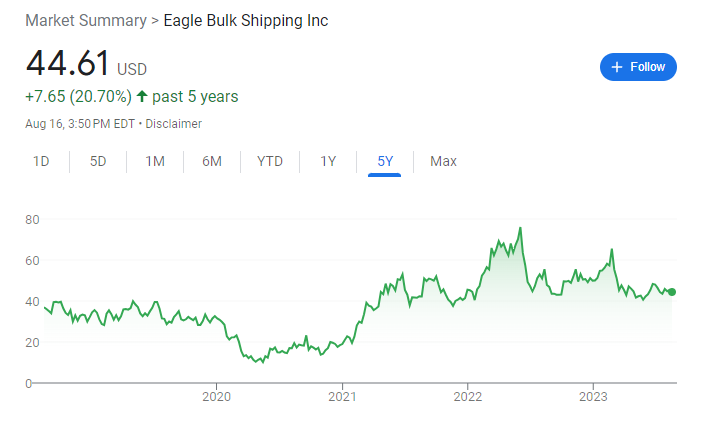
Eagle Bulk Shipping Inc. (EGLE) is a U.S.-based dry bulk shipping company that provides seaborne transportation of commodities such as iron ore, coal, grain, steel products, and fertilizers.
Eagle Bulk operates a fleet of 64 dry bulk vessels, consisting of 50 Ultramax and 14 Supramax vessels, with an aggregate carrying capacity of approximately 4.1 million deadweight tons1.
Eagle Bulk’s vessels are deployed on spot and time charter contracts with customers such as Cargill, Bunge, Rio Tinto, and Vale2.
Advantages
Eagle Bulk Shipping has several advantages that make it a potential shipping stock for investors. Some of these are:
- Strong financial performance: Eagle Bulk has been profitable for the past four quarters, with a net income of $51.4 million in Q1 2023, compared to a net loss of $11.5 million in Q1 2022. Eagle Bulk’s revenue increased by 15.4% year-over-year to $178.8 million in Q1 2023. Eagle Bulk’s adjusted EBITDA margin was 67.8% in Q1 2023, compared to 54.9% in Q1 2022.
- Value-oriented strategy: Eagle Bulk has implemented a comprehensive value strategy centered around low financial leverage, fleet expansion, and shareholder returns. Eagle Bulk has reduced its net debt by $236 million since the end of 2019, resulting in a net debt-to-EBITDA ratio of 1.6 as of March 31, 2023. Eagle Bulk has also acquired six modern fuel-efficient vessels in 2023 to enhance its fleet profile and earnings potential. Moreover, Eagle Bulk has initiated a regular quarterly dividend policy with a target payout ratio of 60% to 80% of adjusted net income.
- Growth opportunities: Eagle Bulk has identified several growth opportunities in the global dry bulk shipping market, which is expected to benefit from strong demand recovery and supply constraints in the post-pandemic era. Eagle Bulk plans to leverage its diversified fleet, which gives it exposure to all major and minor bulk commodities, to capture the upside potential of the market. Eagle Bulk also aims to capitalize on the favorable market conditions to increase its charter rates and utilization.
Disadvantages
Eagle Bulk Shipping also faces some challenges and risks that may affect its future performance and valuation. Some of these are:
- High competition: The dry bulk shipping industry is highly competitive, with several players such as Star Bulk Carriers Corp. (SBLK), Golden Ocean Group Limited (GOGL), and Safe Bulkers Inc. (SB) competing for market share. These competitors may have greater financial resources, operational scale, and bargaining power than Eagle Bulk, and may offer lower prices or better services to attract customers. Eagle Bulk may also face competition from new entrants or alternative modes of transportation.
- Cyclical and volatile industry: The dry bulk shipping industry is subject to cyclical fluctuations and volatility due to changes in supply and demand, economic conditions, trade policies, fuel prices, exchange rates, environmental regulations, and other factors that may affect Eagle Bulk’s revenue, profitability, cash flow, and asset values. For example, the COVID-19 pandemic caused significant disruptions and uncertainties in the industry in 2020 and 2021.
- Operational risks: Eagle Bulk’s operations are exposed to various risks such as accidents, delays, disruptions, damages, losses, claims, liabilities, fines, penalties, lawsuits, strikes, piracy, terrorism, natural disasters, pandemics, cyberattacks, and other events that may affect its vessels, containers, cargo, personnel, customers, suppliers, partners, or reputation. These risks may result in increased costs or reduced revenues for Eagle Bulk.
Anchoring Our Thoughts: The Vast Ocean of Opportunities Ahead
As we've traversed the waters of the shipping sector, it becomes clear that 2023 is not just another year on the maritime calendar. It's a nexus of technological innovation, evolving trade dynamics, and robust market potentials.
The shipping titans and emerging players we've explored represent the best of a thriving industry, each propelling forward with its own strategy, strengths, and vision. For investors, the horizon is broad, filled with both challenges and opportunities.
But as with any journey, it's essential to remain informed, vigilant, and adaptable. The currents of global commerce are ever-changing, and so are its investment prospects.
Thank you for joining us on this voyage.
May your investment sails catch favorable winds, and may you find safe harbors in the storms. Until our next maritime market exploration, fair winds and following seas!
Get High Return Stocks!
Read my review below to see the best place to get stock ideas:
0 comments